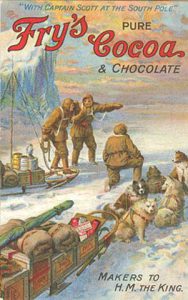Fueling Expeditions to the Ends of the Earth

With its hot, filling, rejuvenating qualities, cocoa has been an essential staple on all the major expeditions to the North and South Poles. Men would drink cup after cup of it as a bulwark against the morale and strength-sapping task of trudging across an icy, austere landscape.
But explorers have not been unanimous in their opinion and preference for cocoa. Apsley Cherry-Garrard wrote in his diary, “Many controversies raged over the rival merits of tea and cocoa,” and Captain Robert Falcon Scott noted that, “Feeling went deepest on the subject of tea versus cocoa”. He himself, sided with tea, “…admitting all that can be said concerning stimulation and reaction, I am inclined to see much in favour of tea. Why should not one be mildly stimulated during the marching hours?”
Captain Robert Falcon Scott
Captain Scott requested a strong blend of black tea be created for the Terra Nova expedition, which was intended to fortify the team during the journey. Typhoo, through a brand called Ridgways, supplied the original tea and coffee for Scott’s last expedition. In 2008 the company produced a special blend, appropriately named “Captain Scott’s Strong Blend”, in honor of the explorer. The blend is a replicate of the original blend that traveled with the Scott 1910-1913 expedition and a small amount of the purchase price goes to the Antarctic Heritage Trust, to aid in the preservation of Scott’s Hut.
Even though Scott preferred tea, he still recognized the merits of cocoa for his team. During his 1911-12 trek to the South Pole, he had his men drink hot cocoa five nights a week. Each evening when they stopped for supper, they warmed up one pot of what they called “hoosh” — a thick stew made with pemmican (dried beef and fat) and hard biscuits – and a pot of cocoa. They washed the former down with the latter. As Cherry-Garrard noted, “the warmth of your hours of rest depends largely on getting into your bag immediately after you have eaten your hoosh and cocoa.”
According to records, Scott’s daily sledging ration (per man) was 450g of biscuit, 340g of pemmican, 85g of sugar, 57g of butter, 16g of tea and 24g of cocoa. In comparison, Roald Amundsen’s polar rations were 400g biscuits, 375g pemmican, 125g cocoa and 75g dried milk – five times as much cocoa.
Roald Amundsen
Amundsen and his men preferred coffee at Framheim, but drank only hot chocolate while sledging. They carried flasks of hot chocolate for lunch on their depot journeys. But lunch was a rare treat while en route to the Pole. “We…allowed ourselves…a little lunch, an indulgence that had not hitherto been permitted…soon the Primus [stove] was humming in a way that told us it would not be long before the chocolate was ready. It was a heavenly treat, that drink.”
Cocoa even makes a cameo in Olav Bjaarland’s diary describing his arrival at the South Pole, “So now, we have attained the goal of our desires, and the great thing is that we are here as the first men…We have now eaten and drunk our fill of what we can manage; seal steak and biscuits and pemmican and chocolate.” Amundsen too recalls that after making their navigational observations at the Pole, “We put the kettle on to give ourselves a drop of chocolate”. Later in his book, Amundsen describes arriving back at Framheim to his first cup of coffee in 99 days, “And what about the Pole? Have you been there?” — “Yes, of course; otherwise you would hardly have seen us again. Then the coffee kettle was put on…We agreed that it was good outside, but still better at home.” The word ‘tea’ doesn’t appear anywhere in Amundsen’s book.
Douglas Mawson
We know from Mawson’s wonderful account of the Australasian Antarctic Expedition of 1911-1914 in ‘The Home of the Blizzard’ that while on trips away from their hut hauling sledges over the ice, they drank tea for lunch and Cadbury’s cocoa with dried milk and sugar at breakfast and dinner. The cocoa/dried milk/sugar mixture was prepared in the right proportions before setting off on the expedition, while the tea was sewn into small muslin bags ready to be dropped into the cooker. These may have been the world’s first tea bags.
Ernest Shackleton
Likewise, Ernest Shackleton took a mix of tea and cocoa on his 2014 Imperial Transantarctic Expedition, “We shall take with us no stimulants except tea and cocoa. We drink the tea at midday to refresh us for the ‘afternoon’ march. The cocoa is taken last thing at night to preserve body heat during the hours of sleep.” He also took Bovril, a thick salty meat extract, which was the main warm drink that his team had to drink when they were marooned on Elephant Island.
Modern Expeditions
100 years on – what are the preferences of modern-day explorers? We’re pretty certain that feelings still run deep over the relative merits of tea and cocoa, though now a range of other instant, lightweight beverages vie for preference. Cocoa is still a staple (during explorer Will Steger’s 1989 dog-sled journey across Antarctica, he and his team drank over 2,000 cups of Swiss Miss hot chocolate over the 4,000-mile trek). Instant soups add variety to the evening meal and juice crystals are mixed with water for an on-the-trail energy boost. Some expeditions carry tea only as an accessory, while others factor it in as part of the daily ration. In the end, it’s about finding something that provides calories, comfort and a boost to morale in the harshest of conditions. What’s your fuel?